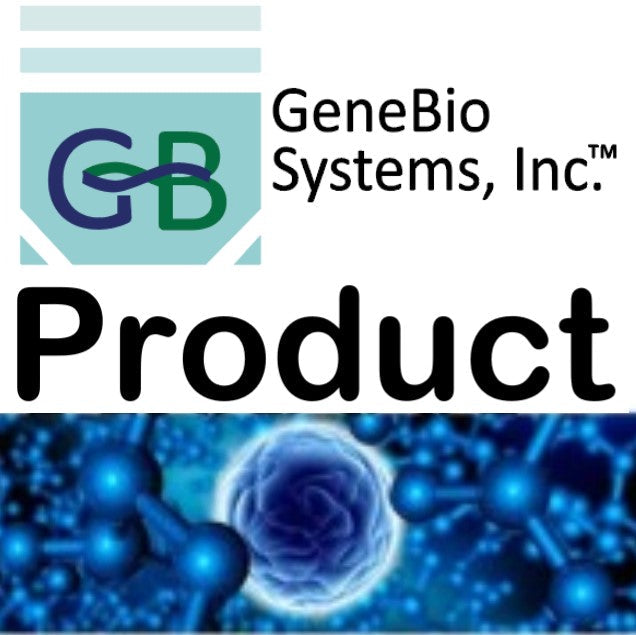Gene Bio Systems
Recombinant Human Cytochrome P450 4F11(CYP4F11)
Recombinant Human Cytochrome P450 4F11(CYP4F11)
SKU:CSB-EP872539HU
Couldn't load pickup availability
Size: 200ug. Other sizes are also available. Please Inquire.
In Stock: No
Lead time: 10-20 working days
Research Topic: Cardiovascular
Uniprot ID: Q9HBI6
Gene Names: CYP4F11
Organism: Homo sapiens (Human)
AA Sequence: TYTFYDNCRRLQCFPQPPKQNWFWGHQGLVTPTEEGMKTLTQLVTTYPQGFKLWLGPTFPLLILCHPDIIRPITSASAAVAPKDMIFYGFLKPWLGDGLLLSGGDKWSRHRRMLTPAFHFNILKPYMKIFNKSVNIMHDKWQRLASEGSARLDMFEHISLMTLDSLQKCVFSFESNCQEKPSEYIAAILELSAFVEKRNQQILLHTDFLYYLTPDGQRFRRACHLVHDFTDAVIQERRCTLPTQGIDDFLKNKAKSKTLDFIDVLLLSKDEDGKELSDEDIRAEADTFMFEGHDTTASGLSWVLYHLAKHPEYQEQCRQEVQELLKDREPIEIEWDDLAQLPFLTMCIKESLRLHPPVPVISRCCTQDFVLPDGRVIPKGIVCLINIIGIHYNPTVWPDPEVYDPFRFDQENIKERSPLAFIPFSAGPRNCIGQAFAMAEMKVVLALTLLHFRILPTHTEPRRKPELILRAEGGLWLRVEPLGANSQ
Expression Region: 38-524aa
Sequence Info: Full Length
Source: E.coli
Tag Info: N-terminal 6xHis-SUMO-tagged
MW: 72.2 kDa
Alternative Name(s): 3-hydroxy fatty acids omega-hydroxylase CYP4F11Curated (EC:1.14.13.-Curated)Cytochrome P450 4F11 ;CYPIVF11
Relevance: Omega-hydroxylase that oxidizes a variety of structurally unrelated compounds, including fatty acids and xenobiotics. Plays a key role in vitamin K catabolism by mediating omega-hydroxylation of vitamin K1 (phylloquinone), and menaquinone-4 (MK-4), a form of vitamin K2. Hydroxylation of phylloquinone and MK-4 probably regulates blood coagulation . Catalyzes omega-hydroxylation of 3-hydroxy fatty acids, such as 3-hydroxypalmitate, 3-hydroxyoleate, 3-hydroxyarachidonate, and 3-hydroxystearate . Oxidizes drugs such as erythromycin, benzphetamine, ethylmorphine, chlorpromazine and imipramine .
Reference: The DNA sequence and biology of human chromosome 19.Grimwood J., Gordon L.A., Olsen A.S., Terry A., Schmutz J., Lamerdin J.E., Hellsten U., Goodstein D., Couronne O., Tran-Gyamfi M., Aerts A., Altherr M., Ashworth L., Bajorek E., Black S., Branscomb E., Caenepeel S., Carrano A.V. , Caoile C., Chan Y.M., Christensen M., Cleland C.A., Copeland A., Dalin E., Dehal P., Denys M., Detter J.C., Escobar J., Flowers D., Fotopulos D., Garcia C., Georgescu A.M., Glavina T., Gomez M., Gonzales E., Groza M., Hammon N., Hawkins T., Haydu L., Ho I., Huang W., Israni S., Jett J., Kadner K., Kimball H., Kobayashi A., Larionov V., Leem S.-H., Lopez F., Lou Y., Lowry S., Malfatti S., Martinez D., McCready P.M., Medina C., Morgan J., Nelson K., Nolan M., Ovcharenko I., Pitluck S., Pollard M., Popkie A.P., Predki P., Quan G., Ramirez L., Rash S., Retterer J., Rodriguez A., Rogers S., Salamov A., Salazar A., She X., Smith D., Slezak T., Solovyev V., Thayer N., Tice H., Tsai M., Ustaszewska A., Vo N., Wagner M., Wheeler J., Wu K., Xie G., Yang J., Dubchak I., Furey T.S., DeJong P., Dickson M., Gordon D., Eichler E.E., Pennacchio L.A., Richardson P., Stubbs L., Rokhsar D.S., Myers R.M., Rubin E.M., Lucas S.M.Nature 428:529-535(2004)
Purity: Greater than 90% as determined by SDS-PAGE.
Storage Buffer: Tris-based buffer,50% glycerol
Storage: The shelf life is related to many factors, storage state, buffer ingredients, storage temperature and the stability of the protein itself. Generally, the shelf life of liquid form is 6 months at -20℃/-80℃. The shelf life of lyophilized form is 12 months at -20℃/-80℃.
Notes: Repeated freezing and thawing is not recommended. Store working aliquots at 4℃ for up to one week.


